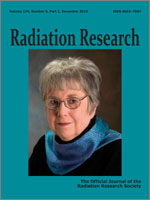Relatively few data are available on the prevalence of hyperthyroidism (TSH concentrations of <0.3 mIU/liter, with normal or elevated concentrations of free T4) in individuals exposed to radioiodines at low levels. The accident at the Chornobyl (Chernobyl) nuclear plant in Ukraine on April 26, 1986 exposed large numbers of residents to radioactive fallout, principally to iodine-131 (131I) (mean and median doses = 0.6 Gy and 0.2 Gy). We investigated the relationship between 131I and prevalent hyperthyroidism among 11,853 individuals exposed as children or adolescents in Ukraine who underwent an in-depth, standardized thyroid gland screening examination 12–14 years later. Radioactivity measurements taken shortly after the accident were available for all subjects and were used to estimate individual thyroid doses. We identified 76 cases of hyperthyroidism (11 overt, 65 subclinical). Using logistic regression, we tested a variety of continuous risk models and conducted categorical analyses for all subjects combined and for females (53 cases, n = 5,767) and males (23 cases, n = 6,086) separately but found no convincing evidence of a dose–response relationship between 131I and hyperthyroidism. There was some suggestion of elevated risk among females in an analysis based on a dichotomous dose model with a threshold of 0.5 Gy chosen empirically (OR = 1.86, P = 0.06), but the statistical significance level was reduced (P = 0.13) in a formal analysis with an estimated threshold. In summary, after a thorough exploration of the data, we found no statistically significant dose–response relationship between individual 131I thyroid doses and prevalent hyperthyroidism.
How to translate text using browser tools
7 October 2010
Prevalence of Hyperthyroidism after Exposure during Childhood or Adolescence to Radioiodines from the Chornobyl Nuclear Accident: Dose–Response Results from the Ukrainian-American Cohort Study
M. Hatch,
K. Furukawa,
A. Brenner,
V. Olinjyk,
E. Ron,
L. Zablotska,
G. Terekhova,
R. McConnell,
V. Markov,
V. Shpak,
E. Ostroumova,
A. Bouville,
M. Tronko
ACCESS THE FULL ARTICLE

Radiation Research
Vol. 174 • No. 6a
December 2010
Vol. 174 • No. 6a
December 2010




